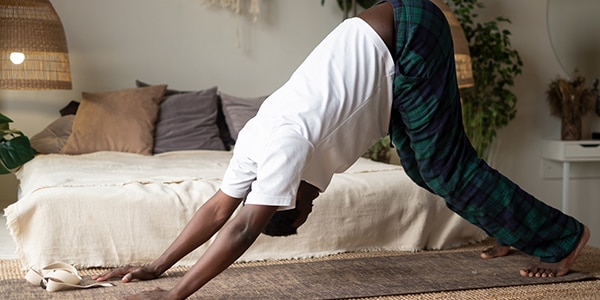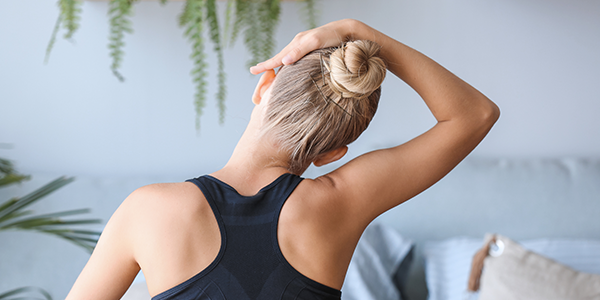A good night’s sleep is essential to good health — but many people struggle to snooze through the night. Not getting enough shuteye is linked to chronic conditions, including heart disease, obesity, and depression.1 One way to improve your rest and relaxation is by adding stretching to your evening routine.
"Stretching is going to help you relieve tension that you’ve built up during the day," says Andy Gallardo, a certified personal trainer and director of employee wellness at Kaiser Permanente. "It will not only help you fall asleep quicker, but will help you wake up a lot more rested."
In addition to improving your sleep, stretching keeps your muscles flexible, strong, and healthy — and that flexibility helps maintain a range of motion in your joints.2 Stretching is also a simple way to reduce your risk of injury. It can even boost your overall sense of well-being, especially when you stretch with mindfulness.
The benefits of mindful stretching
Mindfulness simply means awareness. Being mindful allows you to feel more present in the moment. And a number of studies have found that mindful meditation practices that incorporate gentle stretching, such as yoga, can improve sleep quality, physical performance, and relieve depression.3
According to Gallardo, stretching mindfully can help you release negative thoughts and anxiety. "Stretching and breathing will help to let some of that go, and hopefully quiet your mind so that you’re not thinking about things as you’re trying to fall asleep."
To stretch mindfully, find a quiet, low-lit space that cues your senses to wind down. As you work through each move, notice what muscles are being stretched. Pay attention to your breathing — and even listen to your heartbeat.
5 simple bedtime stretches
Gallardo recommends a simple mix of yoga poses and static stretches. Here are 5 options to add to your nightly routine.

Upward Dog
Benefits: Great stretch for the chest and spine
- Start by laying down on your stomach, with your legs straight and the tops of your feet pressed down toward the floor.
- Inhale and use your arms to push yourself up halfway. Your hips and upper torso should be lifted off the ground.
- Keep your arms straight, shoulders lifted, and your head aligned with your arms.
Hold for 5 breaths or 30 seconds.

Downward Dog
Benefits: Relieves tension from neck and back
- Move into Downward Dog by coming down to the floor and getting on all fours.
- Make sure your knees are slightly behind your hips and your hands are shoulder-width apart.
- Take a deep breath pressing your hands into the ground, lift your knees off the floor, and straighten your legs. Keep your knees bent just a bit to prevent injury.
Hold for 5 breaths or 30 seconds.

Neck Stretch
Benefits: Relieves stiffness and improves range of motion
- Sit up straight at the edge of your bed.
- Keep your eyes forward, and tilt your left ear toward your left shoulder.
Hold for 20 to 30 seconds, and then switch to your right shoulder. Repeat 3 times on both sides.

90/90 Hip Stretch
Benefits: Great for hip mobility
- Begin with both your legs at 90-degree angles. One leg in front, the other out to the side.
- Lay your hands flat on the ground on either side of your front leg.
- Bring your chest and head forward, leaning over the front leg as much as you can while keeping both knees firmly on the ground.
Hold for 10 to 20 seconds, and then rotate to the other side.
Note: After completing this stretch, you can move into a modified Pigeon stretch as seen in the above image. Slowly straighten your leg that’s at a 90-degree angle. You can keep your leg slightly bent if that’s more comfortable. Keep your hips square, breathe, and hold for 10 to 20 seconds.

Child’s Pose
Benefits: Stretches the lower back and inner thighs
- Kneel on the floor with your toes together and your knees hip-width apart.
- As you exhale, lower your torso between your knees and sit back on your heels.
- Reach your arms out in front of you while keeping your head as close to the ground as possible.
Hold this stretch for as long as you’d like.
Finishing with Child’s Pose is a good way to mindfully end your routine and get into a state of relaxation. For more stretching exercises, visit our online Health Encyclopedia.
